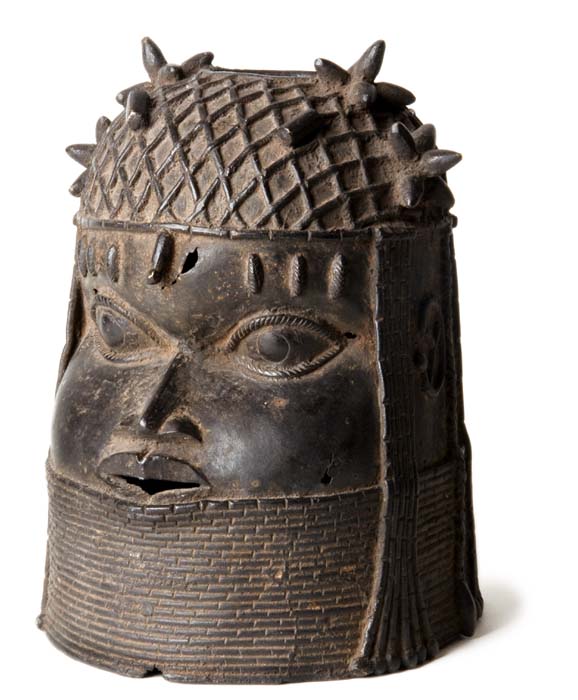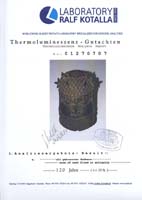| Galerie Peter Herrmann | ||||
| Ancient Art from Africa | ||||
 |
| Photo: Peter Herrmann |
| Thermoluminescence - Expertise | Head |
 |
Benin, Nigeria appr. 1880 Bronze 24 cm |
| Provenience |
| Collection Paul Garn, Dresden. Bought 1920's. |
| Head of an Important Person |
The facial characteristics of this head are highly stylised, particularly the large eyes and even the outlines of eyebrows have been suggested. Rosettes of large, conical pearls are affixed to the sides of the pearl cap, and strings of pearls attached to that cap hang down in front of and behind the ears. In addition, a single pearl is attached to the centre of the forehead and on each side of it, three bulging protrusions are affixed to the forehead, meant to represent decorative scars. Instead of a neck, the head is endowed with several coral chokers, which have been interpreted as evidence of the subject's wealth. The only thing known with certainty about the identity of this memorial head is that it is an important Beninese person. In 1919, Luschan argued that all heads of this type without plinths are meant to represent female figures, and in 1963, William Fagg gave a similar head the gender-neutral title, "Bronze Head for the Royal Ancestral Altar." According to Fagg's observations, such heads were ever more stereotypically rendered over the years; as such, he argues, their primary purpose most likely became solely the displaying of ivory teeth. The precious teeth, on which all the achievements of the king were illustrated, were symbols of authority and wealth and were mounted in the opening on the head, which was created specifically for that purpose. The latest research indicates that this head depicts a man - more specifically, that it is a symbolic depiction of an Oba (king of Benin). Vgl.: |
| Auction results |
Sotheby's, Christies: Examples |
| Similar objects | Illustration |
| Museum für Völkerkunde, Wien; British Museum, London; Bristol City Museum |
Philip J. C. DARK: An introduction to Benin art and technology, Oxford 1973, Tafel 25, 26. |
Ekpo EYO, Frank Willett: Kunstschätze aus Alt-Nigeria, Mainz 1983, S. 136. |
Staatliche Museen zu Berlin, Ethnologisches Museum |
Felix von LUSCHAN: Die Altertümer von Benin, Band 1-3, Berlin 1919, Tafel 55. |
| Museum für Völkerkunde, Wien, Slg. A. Maschmann |
Armand DUCHATEAU: Benin. Kunst einer afrikanischen Königskultur, München 1995, S. 38, 39, 46, 47. |
| Museum für Völkerkunde, Wien, Slg. Hans Meyer |
Barbara PLANKENSTEINER (Hg.): Benin. Könige und Rituale. Höfische Kunst aus Nigeria, Wien 2007, S. 373. |
| British Museum, London |
W./ B. FORMAN, Philip DARK: Die Kunst von Benin, Prag 1960, Tafel 68, 69, 70. |
Till Förster: Kunst in Afrika, Köln 1988, S. 101. |
Nationalmuseum Lagos |
Schätze aus Alt-Nigeria. Ministerium für Kultur, Berlin (Ost) 1985, S. 138. |
Museum für Völkerkunde zu Leipzig, Grassimuseum |
Kunst aus Benin. Afrikanische Meisterwerke aus der Sammlung Hans Meyer, Grassimuseum, Leipzig 2002, S. 73. |
General Pitt Rivers's Museum at Farnham, Dorset |
Augustus Henry PITT-RIVERS: Antique Works of Art from Benin, London 1900 (Reprint 1971), S. 31. |
Frank WILLETT: Ife. Metropole afrikanischer Kunst, Bergisch Gladbach 1967, S. 189. |
British Museum, London |
William B. FAGG: Bildwerke aus Nigeria, München 1963, S. 41. |
| Paul Garn Collection |